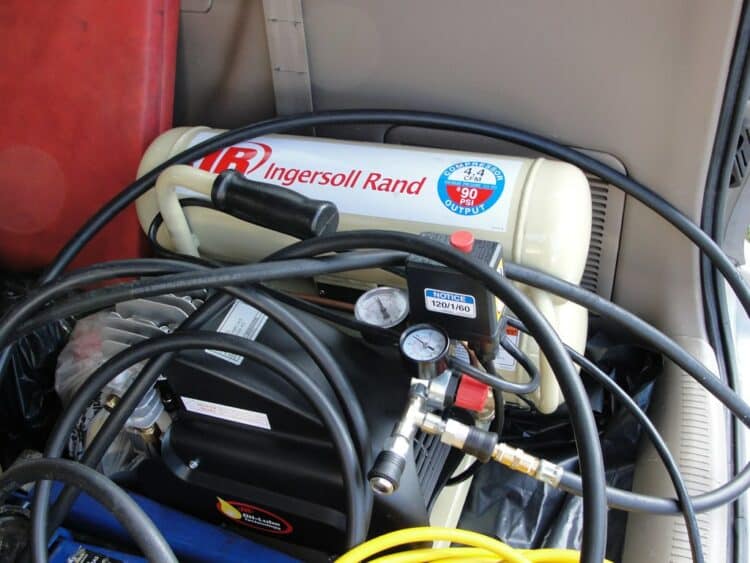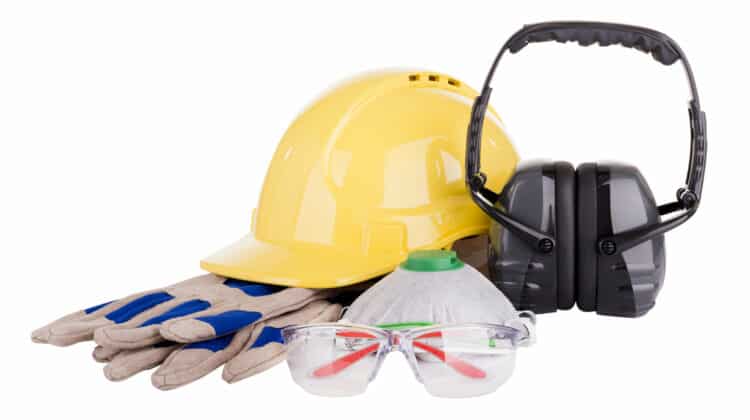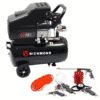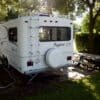
Many people all over the country need Co2 tanks. They use them at home and in their jobs. Whether you use a Co2 tank often or not makes no difference. At some point, it will run out of air. You have to refill it. But doing so takes up both time and money, which some of us do not have to spare. What if I told you there is a simpler and cheaper way? With the right set of tools, knowledge, and instructions, you can refill any Co2 tank yourself. The best part is, you can do this at no extra cost to you. Let’s learn how to refill Co2 tank with air compressor.
Before we get into the how’s of it, let’s answer a few pertinent questions.
Table of Contents
Co2 vs Compressed Air
When you refill a Co2 tank by feeding it compressed air, that’s what you will get. A compressed air unit does not dispense pure Co2.
If you want Co2 in your tank, you cannot use an air compressor. For that, you need a larger Co2 tank. That being said, it is possible to switch the air in youru Co2 to make it compressed air.
How To Refill Co2 With Air Compressor – Liquid vs Gas Co2
Gaseous Carbon dioxide is the same as the liquid form.
Gaseous carbon dioxide can be cooled into a liquid state to form liquid carbon dioxide. That only happens at the right temperature and atmospheric pressure.
The right temperature is 31 degrees C and the correct atmospheric pressure 4.18.
But when you fill Co2 tanks, the liquid goes back to being gas. The long and short is, liquid Co2 and gaseous Co2 are the same. You freeze the gaseous form to get the liquid.
What Is The Cost Of Refilling A Co2 Tank?
The answer to that question depends a lot on what size Co2 tank you own. The smaller the tank, the less money you pay. The larger the tank, the more money you pay for each refill. Be prepared to pay anywhere from $15 to $30 each time you refill your tank. But those prices depend on the size.
It might not seem like much, but if you use your Co2 tank often enough and refill it often enough, those numbers add up. Learning how to refill Co2 tank with air compressor yourself is a great way to save a few dollars.
Is Using Air Compressors To Refill Co2 Tank A Safe Practice?
Refilling a Co2 tank with compressed air is a simple and safe practice. But, it is best to learn to do it the right way. If you are not careful, the Co2 tank you are refilling could explode. An explosion may cause injury to you. People around you could also be hurt. You may also cause property damage.
How To Refill Co2 Tank With Air Compressor Safely – What You Need To Know
All Co2 tanks are a potential hazard if not handled the correct way, that includes when refilling.
Before you try to fill Co2 tanks using air compressors, there are a few things you need to know. Having this knowledge will help you refill your Co2 tank safely.
Keep in mind that our safety tips regarding how to refill Co2 tank with air compressor are not meant to scare you. So, do not be alarmed. Refilling Co2 tanks with air compressors is a simple and quick task. But you also want to preserve your health and property from suffering damage.
Is It Hydro-Tested?
All pressurized tanks are hydro-tested before hitting store shelves. Hydro-testing tests vessels like Co2 tanks for leaks. The also test the strength of the bottle.
Even after buying your new Co2 tank, the law requires you to test it at least once every five years.
These tests ensure that refilling your Co2 tank is not a hazard. Do not refill your tank until you are sure of your last hydro-test date. If it happened past five years ago, you are due to get one.
If you are sure your tank is not due for a test, I suggest bringing it in for a thorough inspection. Most fill stations do hydro-testing.
If your hydro-test date is okay, then there is nothing stopping you from refilling your tank. Even so it is a good idea to perform a thorough inspection of your tank first. That’s the best way to avoid mishaps when you refill Co2 tank with air compressors.
How To Inspect Your Co2 Tank
Here is a list of things to look for before refilling Co2 tanks using air compressors.
Check The Tank For Crown Markings
Crown Markings are symbols that give descriptions of different specs of your tank. Each crown marking has a description of various things about your Co2 tank. You can find information about:
The size of your tank
Knowing your Co2 tank size is an easy way to avoid mishaps when refilling with air compressors. The tank size lets you know how much air the tank holds and how long you should spend filling it. For example, you need about 16 seconds to fill an 8-ounce tank.
Do not overfill your Co2 tank. Over-filling your Co2 tank with too much air may:
- damage the tank
The tank may rupture or even explode
- damage the air compressor
- cause injury to you
Look for crown markings on your Co2 tank for information on the size of your tank.
Look For Signs Of Excessive Wear And Damage.
Filling a damaged or faulty Co2 tank is dangerous. Before refilling your Co2 tank, inspect both the cylinder and the valve for signs of damage or wear.
Signs of Damage and wear don’t always mean your tank is useless. There is an acceptable amount of damage a Co2 tank can have before you need to replace it. But, it is a good idea to get the opinion of a professional if you notice any of the following:
- dents
- gouges
- drag marks
These are a sign of structural damage and could be hiding holes that you may not see by looking.
Check For Signs of Fire And High Heat Exposure
Signs of fire and high heat exposure manifest in different ways. Here’s what you should look for.
- Discoloration of tank paint or labels
- Discoloration includes charring, blistering, or both.
- Tank body distortion
- Melted parts; including handle and valve handwheel
- An activated pressure relief valve
Do not fill a Co2 tank that has signs of exposure to extreme heat or fire. Take your tank to an expert for examination to determine if refilling it is safe.
Examine The Valve’s Safety Relief Tool
Check to see if the valve’s safety relief has been triggered or tampered with in any way. Filling a tank with an activated or altered safety relief is dangerous.
Examine The Valve
Check to see that you have the correct valve for your Co2 tank.
Ensure the connection between the valve and the tank is well sealed.
Ensure the handwheel as well as the outlet threads have no damage. To check the handwheel, open it to a small degree to find out if it works. Also, check the Co2 tank for charge.
Filling a Co2 tank that has a wrong or broken valve is also dangerous.
If you inspect your Co2 tank and notice any of the problems mentioned, seek out an expert. Do not fill the tank on your own.
Wear Protective Eyewear
Most injuries related to air compressor use affect the eyes. That’s because air compressors release air at very high speeds.
The fast-moving air propels debris and any other loose particles. Using protective eyewear will shield your eyes from these flying particles.
Wear Gloves
Gloves are a good idea when refilling Co2 tanks with air compressors. That’s because your hands are exposed to pressured air. Exposure to pressurized air could lead to injury. Based on the application you use air compressors to complete, the damage could be worse. For example, liquid Co2 is cooled air. If it comes into contact with your skin for a short while, it is harmless. But over a long period, it freezes the skin cells and causes something called ice burn. Getting an ice burn is like a sunburn.
It doesn’t always happen, wearing gloves as a precaution will protect your hands.
Practicing safety is essential when using air compressors to refill your Co2 tank. Here are a few more quick safety tips you can follow.
- Put away all flammable materials.
Your Co2 tank should not be near anything flammable at any time. That is to prevent fires or explosions.
- Ensure your Co2 is somewhere secure. You do not want to drop it.
Dropping the tank could cause it to puncture. Inhaling high amounts of Co2 is dangerous. When refilling your Co2 tank, do in a well-ventilated area.
- Never lose focus when using air compressors.
- Stay alert while refilling your Co2 tank.
That way, you ensure that you are doing everything the correct way.
You’ve followed all the steps above. You know that it is safe to refill Co2 tanks with air compressors. You’re wearing your protective wear. It is time to connect your Co2 tank to your air compressor hose and fill it up.
Find The Correct Fit
Not all Co2 tanks and compressors have the same size fitting. And without a proper fit, the measurements to refill your Co2 tank will be off.
The wrong size fittings mean the hose will not sit well on the tank. That could interfere with the amount of air that goes into the tank. You may underfill the tank, which means it will run out of air faster. You may also overfill the tank, which could be harmful to your tank and the compressor. You also want to avoid causing injury to yourself in the process.
To make up for the difference in size, you can use a fill adapter to connect the hose of your air compressor to your tank.
Here’s another thing about finding the right fit. Let’s say the fitting on your air compressor is the correct size for the fitting on your Co2 tank. But the threading may no match. Sometimes, the threading on an air compressor fitting is different from the threading on a Co2 tank fitting.
In that case, you also need to get a fill adapter with threading that matches your Co2 tank fitting.
Take the specs of your Co2 tank fitting to your local hardware store. They should be able to find you what you need. You can also order your fitting online. But, at the hardware store, there is less room for error.
What Is The Takeaway On How To Refill Co2 Tank With Air Compressor Correct Fitting?
There are a few things to take away here. The first is, before you join your air compressor to your Co2 tank, ensure the fittings fit well together.
The second is, even if you have the correct size fitting, the threading also needs to match.
The third is, you can buy a fill adapter to make the difference in both size and threading.
These adapters attach with ease. They are inexpensive investments and will come in handy for other DIY projects as well.
You have the correct fitting. Connect the Co2 tank fitting and the fitting at the end of your air compressor. That’s the first step to refilling your Co2 tank. Here’s the second.
Bleed The Tank Of LeftOver Air
It’s better and safer to refill an empty Co2 tank. Locate the air bleed valve on your Co2 tank. You will find it on top of the Co2 tank fitting. Unscrew the air bleed valve to release any air remaining in the tank. As a precaution, you should do this even if you think the tank is empty. Because leftover air will also affect how much air you should refill your tank with.
You can use a scale to help you do this. Verify the weight of your empty tank. Place the tank on the scale during bleeding. Once the scale registers the weight of the empty tank then you know that you completed the bleed.
Once you’ve drained your Co2 tank of any remaining air, close the air bleed valve. If it remains open, the air you refill the tank with will bleed right out.
It is now time to refill it.
Set A Timer
There are different size Co2 tanks. Some are small as 8 ounces. To refill your Co2 tank with the correct amount of air, you need to know its size. The crown markings we mentioned earlier should provide that information.
Multiply the size of your tank by 2. That final number lets you know how much time you should spend running the air compressor to fill your tank. Here is an example.
If you have an 8-ounce tank, multiply the number 8 by 2. That gives you 16. It means you need to run the air compressor for 16 seconds to refill your 8-ounce tank. To keep track and lessen the risk of error, using a timer or stopwatch is a good idea.
Begin the countdown from the moment you hit the on switch on your air compressor. Of course, it is better to underfill than overfill the tank. It is okay to shut off the compressor with a second or two to spare. Doing so prevents your equipment from suffering damage. You also avoid causing injury to yourself.
Know Your Air Compressor
You cannot use a low-pressure pump to fill your Co2 tank. So, a hand pump or tire pump won’t do the job. Only air compressors that dispense the correct PSI that matches your tank will work.
Look at the crown markings on your Co2 tank to find that information.
After Filling
Once the time you set for refilling the Co2 tank is up, hit the off button on the air compressor. But that’s not all you need to do.
You also have to reopen the air bleed valve for up to about two seconds. You do this to clear the lines so there won’t be any build-up. After those two seconds pass, close the air bleed valve. Ensure that you shut it tightly to prevent leaks.
Drawbacks Of Refilling Co2 Tank With Air Compressor
To be sure, it is better to refill Co2 tanks with Co2. It is safer and produces better results because that’s what Co2 tanks are built for.
Co2 tanks have many applications. Depending on what you plan to use Co2 for, compressed air might not work at all.
Here are some examples of when it is okay and not okay to use air compressors to refill Co2 tanks.
Refill Co2 Tank With Air Compressor – Beer Keg
When making homemade beer, it is better to avoid using pressurized air in the keg. According to beer enthusiasts, it ruins the quality of the brew. That’s because air compressors use oil. The oil then mixes with your homemade brew, giving it a foul odor and taste.
But handling carbon dioxide by yourself is not recommended if you are not a professional. And of course, this will cost you more money and take up some time.
Refill Co2 Tank With Air Compressor – Paintball Gun
There are mixed reports on refilling Co2 tank paintball guns with air compressors. Some people are against the idea and cite it as dangerous. Others claim to have used this method and say that it is safe.
To get a better understanding of this, let’s take a look at a few things.
Paintball gun tanks are made from different materials.
Co2 Tanks
You can find both aluminum and steel Co2 tanks. Some of these tanks are a combination of both these materials.
Compressed Air Tanks
There are two types of compressed air tanks. The first has a PSI rating of 3000 and is made of aluminum. The second has a PSI rating of 4500, is much lighter, and is made using carbon fiber.
So can you switch it up by putting compressed air into the Co2 tank? Yes, you can. Here’s why.
Co2 tanks are rated only at 1800 PSI. So, an air compressor of 3000 PSI or greater is more than enough to do the job.
But as with the homemade brew, the quality of the results may not be the same. Your shots may not have the correct range and you may not have the same number of shots per tank.
But you might be short on cash. You still want to have some quick paintball fun. Your air compressor is an adequate substitute.
The Takeaway
Some Co2 tanks and compressed air tanks are made using the same materials. That means it is possible to refill your Co2 tank with an air compressor.
Important Note
Refilling Co2 fire extinguishers with air compressors is not a recommended practice. The same goes for medical equipment with. These should only be attended to by professionals in the field.
Never replace the Co2 in your fire extinguisher or medical equipment with Co2.
Will Refilling Co2 Tank With Air Compressor Cause Damage To Both Tools?
Some reports say refilling Co2 tanks with air compressors may damage both pieces of equipment. Yet, there are no specifics on the type of damage they may suffer.
Here’s my take on this.
Air compressors do use oil and the oil may mix with the air it dispenses. But, you should clean out your Co2 tank anyway. Occasional servicing is a good way to get your equipment to last longer.
Conclusion
Switching your tank from Co2 to compressed air is doable and practiced by many people. You can make the transition seamless and safe. Your Co2 tank will continue to do the job you want it to.
Do not be surprised in your notice a difference in the performance of your equipment. But that difference is minimal.
That being said, compressed air is a cheap alternative to Co2.
Remember, all Co2 tanks are a potential hazard if not handled the correct way. When refilling the same applies. Using air compressors to refill them can also be dangerous if you do not exercise caution.





